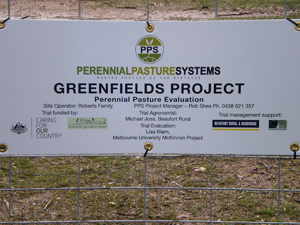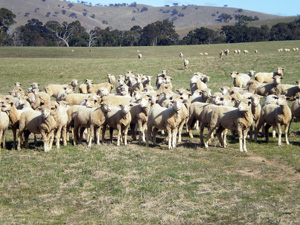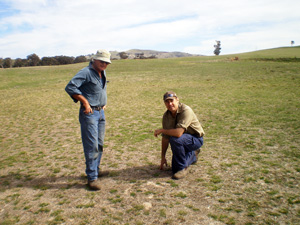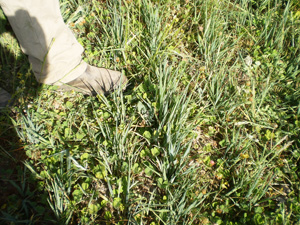Physical and economic analysis of pasture improvement & enterprise change at Glenlofty Victoria 2010 - 2018
Perennial Pasture Systems (PPS) is proposing a project to do a full economic and physical analysis on farm scale changes at a member’s property at Glenlofty. Pasture improvement trials by PPS and others have shown the massive productivity gains possible through the introduction of perennial species into degraded annual pastures which are prevalent in the Upper Wimmera and similar environments. These improved pastures also allow farmers to alter their enterprise mix which improve their profitability.
The replacement of annual pastures with perennials also has significant environmental benefits with improved soil cover reducing soil erosion risk, improved water use reducing salinity risk and reduced nitrate leaching which slows the rate of soil acidification. The new pastures will also assist in adapting to climate variability by extending the growing season of the pasture and being able to respond to unseasonal rainfall events. While many of the region’s farmers have recognised the benefits of perennial pastures, others are reluctant to risk the high establishment costs of new pastures or lack the confidence to apply the management.
This project aims to take a newly purchased low fertility, degraded paddock through the preparation, pasture renovation and refencing for rotational grazing to demonstrate the best practice techniques to establish a productive perennial pasture system. It will also follow the change in the paddock from a low productivity wool producing system to a highly productive lamb enterprise. A full economic analysis is proposed to show the capital return from purchasing this paddock, its pasture improvement and taking it through to the lamb system.
This analysis will show the payback period for such a project in this region. Currently there are several models available for assessing payback period for pasture improvement but many PPS members believe that the payback period can be less than those currently used by advisors and consultants. This project will test the current assumptions. It is hoped that the project can show that a shortened payback period is possible, and potential subsequent profitability for this system will show that investment in perennial pastures is a worthwhile venture for the region’s farming businesses.
Project Location The project will be located at Glenlofty which is situated approximately 40 km North East of Ararat. The paddock is adjacent to the Elmhurst-Landsborough Road in rising country adjoining the foothills of the Pyrenees Ranges. Annual rainfall is approx 600mm. The site is about 1 km from the Upper Wimmera River which adds to the importance of the environmental benefits which come about by replacing annual species with perennials in this part of the catchment.
Project Outline The project aims to take a paddock which has been allowed to become run down and unproductive and re-establish it as a best practice rotational grazing lamb production system. The paddock is typical of many in the Upper Wimmera catchment and other areas of Central Victoria which are producing at well below their optimum because of long term low inputs and set stocking practices which have virtually eliminated productive plant species from the pasture. PPS proposes a period of cropping to reduce weed issues and to allow inputs to build fertility and address soil pH and aluminium toxicity issues. The paddock would then be established as a perennial grass/legume pasture. PPS plans to use the findings from the PPS/Evergraze Mooneys Gap and other trials to establish a best practice phalaris based pasture. The pasture will consist of Holdfast GT phalaris sown with Trikkalla sub clover and Zulu Arrowleaf clover. After pasture establishment the paddock will be subdivided into three separate paddocks to allow for best practice rotational grazing. These changes will allow a change in the production systems from merino wethers running at 5 dse/ha to a prime lamb enterprise with a stocking rate of 9 ewes per ha which will take the paddock to an annual carrying capacity of 15 dse/ha. PPS proposes to measure the physical and economic changes in the pasture system to provide a full analysis of the project.
Expected Outcomes The aim of the project is to ascertain the payback period from the purchase of a rundown paddock, establishment of productive perennial pastures and the imposition of best practice grazing management. The project will allow several learning opportunities during the pasture establishment and management phases and the economic analysis will provide more information to progressive farmers who are considering expanding their enterprises. PPS hopes to provide accurate information of pasture establishment payback periods which should provide greater certainty for farmers who are planning new pastures. PPS anticipates a threefold increase in the carrying capacity of the paddock and an even higher gross margin return due to enterprise change.
Greenfields Paddock History The paddock is 24.4 ha in area and forms part of the 620 ha Eylos-Merther property of A M & S A Roberts. The Greenfields paddock forms part of the” Elizabeth” section of Eylos-Merther and was purchased in 2010. Greenfields has been used for wool production and has had little or no fertiliser for the past 25 years. The soil tests results (see table) show the low fertility of the paddock in 2012. The estimated carrying capacity when purchased was 2 dse/ha, although it was lifted slightly prior to the cropping phase by chemical and mechanical control of the fog grass which dominated the pasture.
📷
Project timeline
Year 1 – 2010 Purchased May 2010 Grazed residual fog grass pasture Spray-topped in late Spring/early summer with Gramoxone to stop seed set.
Year 2 – 2011 Still large quantities of low quality residual pasture Pasture was mechanically topped in late Spring/early summer. Maintain grazing pressure.
Year 3 - 2012 Lower grazing pressure Deep soil test Level rough areas Spray knockdown of glyphosate and Glean with Dimethoate and wetter. Direct drill grazing triticale in Late April Graze triticale measure weight gain and condition score of stock Monitor for RLEM, Lock up for grain production.
Year 4 - 2013 Direct drill Triticale, Second application of spray to control weeds. Application of lime Graze, then lock up for grain production.
Year 5– 2014 Establish pasture
Years 6-8 – 2014/2017 Manage pasture using best practice methods Measure pasture growth Measure pasture composition and species persistence Measure animal production Carry out full economic analysis of pasture improvement program
Year 9 – 2018 Report results
Environmental benefits of Greenfields project The environmental benefits of establishing deep rooted perennial pastures are well documented. The increased soil cover reduces the risk of wind erosion which is further reduced by the implementation of rotational grazing which is vital to the success of the improved system. The increased water use efficiency of the perennial plants also reduce the salinity risk as well as slowing the rate of soil acidification through increased nitrate uptake by the perennials.
The growing season of the new pastures will be longer than the previous pasture and will take advantage of rainfall events that fall outside the normal growing. The new pasture system will be more responsive to variations in climate and allow a productive system to operate through the variable climatic conditions
Top left: Greenfields project gate sign. Top right: Lambs at Greenfields. Bottom left: Michael and son Tony Roberts at Greenfields prior to trial commencement. Bottom right: Greenfields new pasture October 2014.




Comments